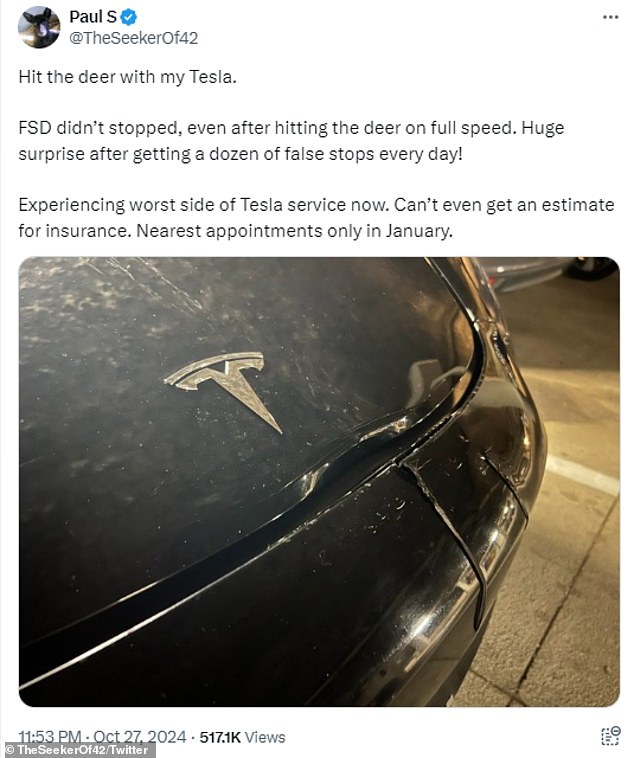This is the shocking moment a Tesla in ‘Full Self-Driving’ (FSD) mode plowed into a deer standing in the middle of the road.
The driver, Paul S, did not confirm when or where the crash occurred, or what model Tesla he was driving. But dashcam footage shows the vehicle driving down a clear two-lane highway at night moments before the animal suddenly came into view.
The Tesla rammed directly into the deer, without stopping or slowing down ‘even after hitting the deer on full speed,’ Paul said.
‘Huge surprise after getting a dozen false stops every day!’ he added.
Paul has not said what became of the animal, but photos showed that the impact left dents and scratches on the hood of the car.
Elon Musk‘s FSD system uses cameras mounted on the front, rear, left and right of the vehicle to detect obstacles and avoid collisions.
The system is also supposed to alert drivers of oncoming obstacles, which did not happen the night that Paul hit the deer.
But it has been mired in controversy due to a recently opened investigation into four reported collisions associated with FSD, including a fatal crash that occurred in 2023.
Last November, a 2021 Tesla Model Y in FSD mode struck a 71-year-old pedestrian in Rimrock Arizona. She was pronounced dead at the scene.
Tesla’s FSD software relies on cameras, which are different from obstacle detection in other vehicles that typically have sensors with radar and sonar to pick up on objects in the car’s path.
It appears that the FSD cameras missed the light-colored deer, which blended in against the lighter-colored pavement.
The cameras should have detected the threat, alerted Paul of the oncoming obstacle through its Forward Collision Warning feature, and maneuvered to avoid a crash.
The driver, X user Paul S (@TheSeekerOf42), said that he is ‘insanely grateful’ to Tesla and the company’s chief designer, Franz von Holzhausen ‘for how well the vehicle structure handled the impact!’
‘I mean, that poor creature could’ve easily gone through the windshield, sending me to my ancestors. But it held. Cracked, scratched up, but it held!’ he posted.
He does have some real concerns about the damage though.
In addition to a cracked bumper, ‘the hood shifted almost an inch toward the windshield, which is cracked and scratched from the deer rolling across it and onto the side, leaving parts on the mirror,’ Paul said.
‘I’m worried the frame under the plastic is bent,’ he added.
Despite this, he defended the FDS software. ‘FSD works awesome! This just an edge case. We probably just need to teach FSD what a deer’s butt looks like,’ he said.
Obstacle-detecting sensors, however, are capable of detecting 3D objects, and may have been able to pick up on the animal standing in the road if the vehicle was equipped with them, according to the automotive news site Jalopnik.
For example, some other cars with automation features use LiDAR – which stands for Light Detection and Ranging.
These sensors use laser pulses to locate objects and measure the distance between them and the vehicle, analyzing the car’s surroundings in 3D.
Musk opted to use cameras instead of sensors in his self-driving Teslas for a couple of reasons, mainly to reduce cost and the number of parts needed for each vehicle, Andrej Karpathy, Tesla’s former head of AI for its automated driving systems, stated in a 2022 interview.

Photos posted on X show damage sustained by a Tesla operating in Full Self-Driving mode when it struck a deer without ever slowing down or stopping
Not only did the car fail to detect the oncoming threat, but it didn’t seem to notice the crash at all.
After striking the unsuspecting deer, the Tesla continued driving forward at the same speed as if nothing ever happened.
Hitting a deer delivers enough force to a vehicle that the impact sensors should have recognized the collision and told the car to pull over, slow down or give control back to the driver.
Collisions involving self-driving Teslas have caused serious injuries, and even fatalities.
While operating in Autopilot mode – which is different from FSD in that it requires the driver to keep their hands on the wheel and be ready to take control – a Tesla Model Y struck 17-year-old Tillman Mitchell moments after he stepped off the school bus, according to the Washington Post.
The car never even slowed down, striking Mitchell at 45 mph in March 2023. He survived, but suffered a fractured neck, a broken leg and had to be placed on a ventilator.
As of October 2024, there have been hundreds of non-fatal crashes involving Teslas that were operating on Autopilot, and 51 reported fatalities.
And on October 18, the The National Highway Traffic Safety Administration (NHTSA) opened an investigation into 2.4 million Tesla vehicles equipped with FSD software after four reported collisions, including a fatal crash that occurred in 2023.
The NHTSA could recall the vehicles if they determine that they pose a serious risk to public safety.
Despite this, Tesla CEO Elon Musk has repeatedly stated that Tesla’s self-driving features are safer than human drivers.
Paul S said he experienced the ‘worst side of Tesla service’ while trying to get an estimate on the damage to his vehicle for insurance and book an appointment for repairs.
Tesla did not immediately respond to DailyMail.com’s request for comment.
This article was originally published by a www.dailymail.co.uk . Read the Original article here. .


